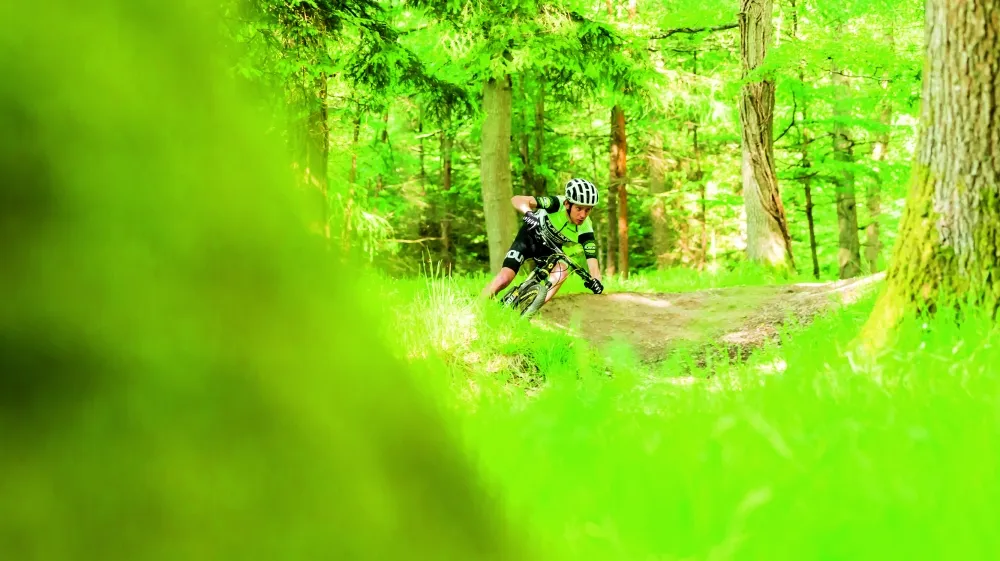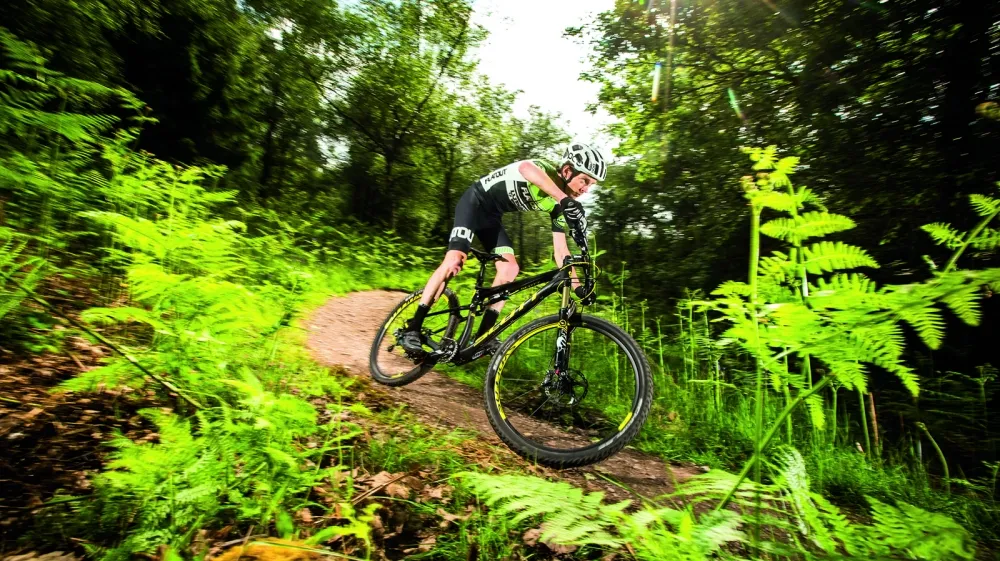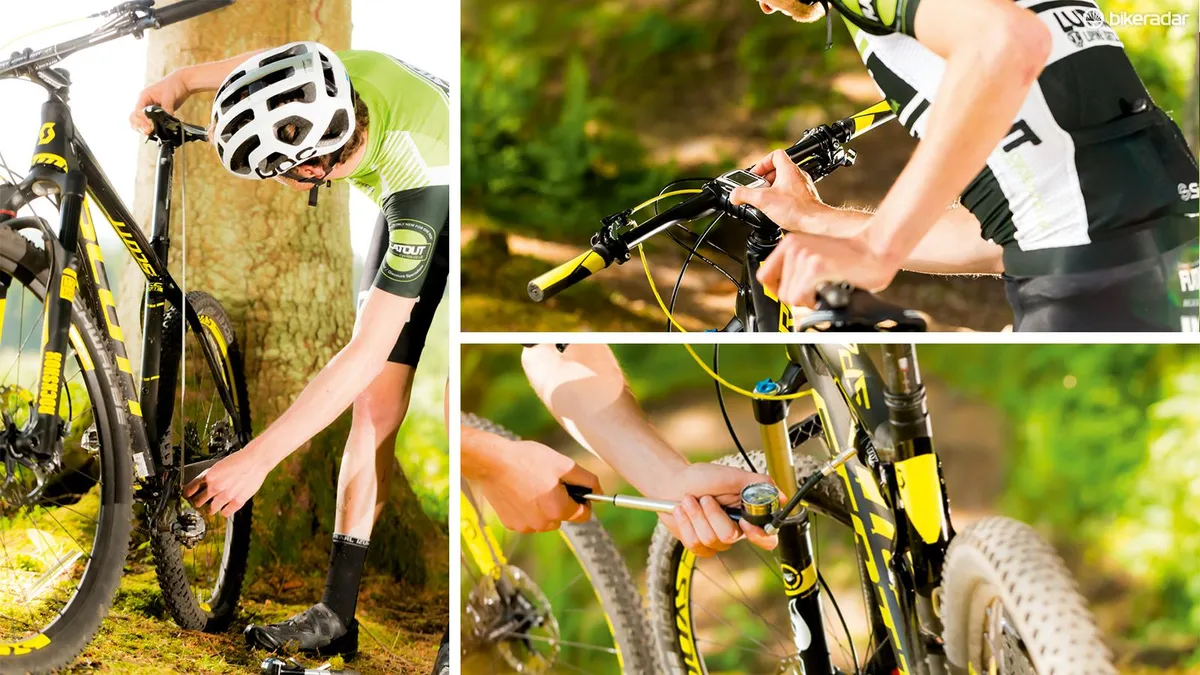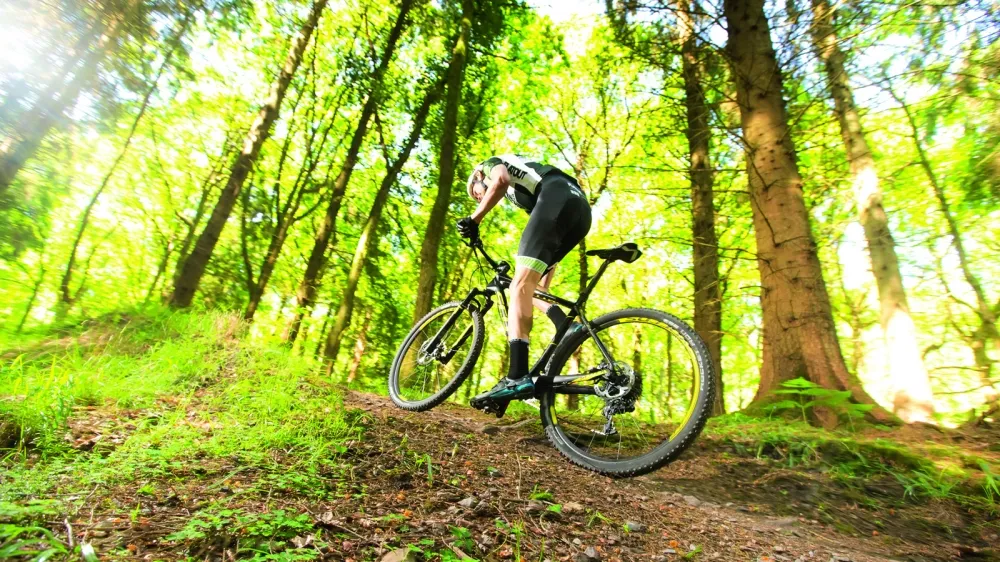If you looked at the start line of a cross-country World Cup 10 years ago nearly every bike would have been a hardtail. Hardtails are simple, lightweight and suited the less technical courses of the era. There may have been a few full suspension bikes, but they came with a weight penalty and compromised pedalling efficiency.
Which is faster: hardtail or full-suspension?
Fast-forward to 2015 and times have changed: races are shorter and contain more technical features and manufacturers have closed the performance gap between hardtails and full suspension bikes. This leaves pros and amateurs alike in a quandary.
Do you go for the super lightweight, razor sharp hardtail or the slightly heavier but more forgiving full suspension bike?

Both, of course, have their pros and cons. Nothing can beat a hardtail for flat-out climbing speed and efficiency, but they suffer on the technical features found on modern cross country courses.
This is where a full-sus machine excels, happily soaking up descents, roots, rock gardens and drops, at the expense of added weight and a slight loss of pedalling efficiency.

With this in mind, we wanted to answer the question: if you could only have one bike, which would it be? We had a good think and decided on the equipment and testing procedure, which while in no way 100 percent scientific, should go some way to providing some real world answers.
So while we're warning you now that the rest of this article contains its share of numbers, testing procedures and results tables, stick with us — the outcome might not be what you anticipated.
Equipment
Scott was kind enough to provide us with two of its top-spec 27.5in race bikes, the hardtail Scale 700RC and the full suspension Spark 700RC. They were perfect for the test, as bar the obvious differences in suspension design they're almost identical in terms of spec.
Both had the same rolling stock, wheels, brakes, contact points and groupset, meaning we should get a fairly true idea of how each bike performed in terms of its suspension alone. The Spark weighed in at 10.29kg / 22.69lb and the Scale a feathery 8.8kg / 19.4lb — both very competitive for their class.
The final piece of the equipment puzzle and probably the most important was a powermeter from Quarq, the XX1 model.
If you're an MTBer unfamiliar with a powermeter, it’s a training aid that measures the power in watts using strain gauges. They’re very popular among road cyclists and have gradually been gaining traction in the mountain bike market, with riders looking to monitor their performance.
Simply put, the more power you can put through the bike, the faster you will go. So although a powermeter doesn’t make you faster in itself, it enables you to accurately gauge your efforts and monitor any improvements in fitness.
The Quarq powermeter would be vital for our test, as I could keep my effort (suffering) consistent and look back over the data when finished
How we tested

To make the test as fair as possible we needed to try and control the variables. Each bike had the same saddle height, suspension setup and air pressure. I used the same power meter on each bike, swapping it between the bikes and recalibrating before each lap.
We used the Forest of Dean on the England/Wales border as our test location as it provided a good mix of terrain and features. We chose two different courses that offered two distinct riding challenges over which to do our laps.
The first course had a lap that was just under 10 minutes. It contained a good mix of doubletrack, tight twisting singletrack, roots, a small rock garden and some short climbs. We called this the ‘rooty’ lap.
The course for the second lap was just over eight minutes, containing a longer doubletrack climb, followed by a steep technical descent with rocks, drops and small jumps. Imaginatively, we called this the ‘rough’ lap. I was particularly interested in this second lap, as it seemed the first half would suit the hardtail, while the second half might advantage the full suspension, giving both an equal chance to shine.
The testing began on the rooty lap with a couple of slow sighting circuits on each bike to scope out the terrain. Then once familiar with the course, I did a full pace rooty lap on each bike, with at least a 40-minute rest between efforts.
I then repeated this procedure on the rough lap, but this time I swapped the order of which bike went first. Pacing was, of course, an issue and I tried to ride the laps just under race pace, to ensure I wasn’t too tired at the end and that all my efforts were as close as possible to being equal. Weather conditions were great and consistent throughout the day.
Results
The table below shows the time in minutes, the normalized power (how hard I was working) and the percentage difference between the bikes against those metrics for each lap. I have also broken down the climb and descent on the rough lap using the same metrics.
Rooty terrain lap
Overall Full susp. Hardtail Hardtail difference % Hardtail diff.
Time mins 9.18.21 9.12.02 6.19 secs faster 1.11% faster
Norm power 316 308 8 watts lower -2.53% less
Rough terrain lap
Descent Full susp. Hardtail Hardtail difference % Hardtail diff.
Time mins 2.12.69 02.24.21 11.52 secs longer 8.68% slower
Norm power 119 132 13 watts higher 10.92% higher
Climb Full susp. Hardtail Hardtail difference % Hardtail diff.
Time mins 3.27.18 3.27.59 0.41 secs longer 0.20% slower
Norm power 392 379 13 watts lower 3.32% less
Overall Full susp. Hardtail Hardtail difference % Hardtail diff.
Time mins 8.04.53 8.11.46 6.93 secs longer 1.43% slower
Norm power 330 322 8 watts lower 2.42% less
Looking at the first rooty lap, the hardtail was 6.19 seconds (1.1 percent) faster than the full suspension, but crucially, the power required was eight watts (2.53 percent) lower. This is the absolute golden ticket of race performance, as it means the hardtail was faster for less effort.
The full suspension was slower and I had to try harder. So although the difference in time may have been marginal, riding the hardtail required less power for a slightly quicker time and comes out a clear winner.
Moving on to the second rough lap, which featured the large climb and descent, the full suspension bike was faster by 6.93 seconds (1.43 percent). This time, more power did produce a faster result, 330np over the hardtail’s 322np. This meant I had to try 2.42 percent harder to go 1.43 percent quicker.
It's difficult to say whether this result is due to simply producing more power or the bike's performance, but data from the climb and descent in isolation reveals some interesting trends.
Looking at the long climb on the second, ‘rough’ lap it’s amazing how close I paced them in terms of time; there was only 0.41 seconds in it with the full suspension coming out on top. But the full suspension loses out in the long run as I had to produce 13 extra watts (3.32%) to go only fractional quicker. This makes sense, as the full suspension bike is heavier, so I would obviously need to try harder to maintain the same speed going uphill.
The descent on the ‘rough’ lap contained the largest differences in percentages for the whole test. The full suspension bike was 11.52 seconds (8.68%) faster – and like the hardtail on the ‘rooty’ lap it went faster (but only in the descent) for less effort, requiring 13 watts (10.92 percent) less power.
I really felt this result on the day, as my arms were in bits by the bottom of the descent on the hardtail, whereas I felt I could have kept on charging with the full suspension.
So what does it all mean?

As stated before, we didn't set out to make any scientific claims here – the sample size was just me and who knows how many riders, bikes, courses and laps you would need in order to iron out the variables. I’d also like to have done more laps in different conditions to see if any other patterns emerged. Riding in the wet or over longer distances may completely change the results, but deadlines and budget have prevented this for now.
Going into this test I was hoping to find some clear conclusions on which bike may be faster, but as you might expect, I have ended up with more questions than answers.
The choice between full suspension and hardtail speaks more widely about how focused modern mountain bikes have become
The hardtail was a winner on the rooty lap, being faster for less effort. But the results were more confusing on the rough lap. The full suspension was quicker on the descent for less power, but required more power to maintain the same speed pretty much everywhere else on the course, particularly going uphill.
This is probably down to extra weight, and over the course of a race the additional effort required from the full suspension could come back to bite you when your power drops in the final laps.
That said, the hardtail isn't immune from end of race fatigue. The Scott Scale is a razor sharp machine, with lightweight and quick handling, but as a consequence you need to be right on top on your fitness on those technical descents. People often make mistakes as they tire at the end of a race and the hardtail will only amplify these errors. So if you’re after something a bit more forgiving, the full suspension Spark would be a better choice, albeit with a small weight penalty.
Another consideration could be budget. The bikes used were top spec and highly competitive in terms of weight and components. The full suspension Spark is as light as some hardtails. Cheaper full suspension bikes come with larger weight penalties, where as a cheap hardtail equivalent can often still be lightweight and easily upgradeable.
So if weight, performance and reliability come high on your list of priorities but your budget it is tight, a hardtail could be the best choice. Conversely, nothing can beat the versatility and fun factor of a full suspension bike. I'm pretty light at 63kg / 138lb and suspect that heavier riders with more power may benefit more from the control a full suspension bike offers.
The choice between full suspension and hardtail speaks more widely about how focused modern mountain bikes have become. Within our sport there are many different disciplines and manufacturers have become adept at making bikes specifically suited to each discipline. The winning percentages in top flight cross country racing are tiny, so pros now have a choice between different bikes to suit different courses and conditions.
Most of us mere mortals don’t have this choice, so we make an informed decision on which type of bike to ride based on the information we have and the riding we do.
This has recently been made harder with the reintroduction of 'softtail' designs such as the BMC Team Elite and the Trek Procaliber. While it's not a new technology, this middle ground could offer somewhere close to ‘the best of both worlds’ and although you might have heard that somewhere before, I will be looking forward to seeing how the BMC and Trek riders fare in the 2015 World Cup.
The verdict
Overall from this test, I'd say for me, the full suspension was a clear winner on the descent, but over the course of a whole lap the hardtail consumed less effort.
You probably spend much less time on the descent than any other section of a race, so the gains from descending on the full suspension may well be lost in the effort required to complete a full lap.
So for the riding I do, it’s still a hardtail. But it’s now so close I could easily be convinced otherwise, sometime soon.
